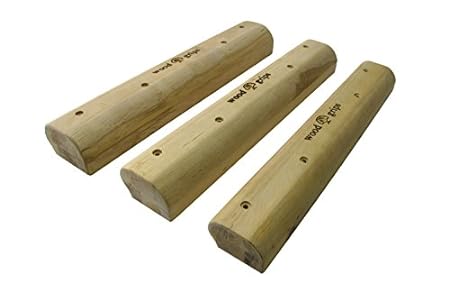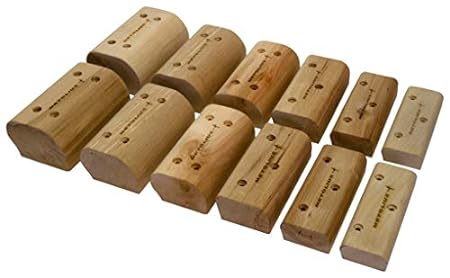Ready to elevate your climbing skills without leaving home? Apart from a usual hangboard, the addition of a campus board to your home gym setup can be a real game changer. With my years of experience in rock climbing and as a certified climber, trust me when I say, these boards are worth your investment. They boost your strength, agility, and power, aspects that are vital for improving your climbing grade.
As an experienced climber who has conquered peaks around the globe from the beautiful crags in Greece to intimidating rock faces in Canada, I’ve used countless climbing equipment. Bet it all, campus boards stand out. They offer targeted and technical training, accelerating your progress to an advanced level.
Let’s jump right into our roundup review of the best campus boards to buy in 2021. You’ll find everything from beginner-friendly boards stretching to more advanced ones, all personally tested and proven efficient by myself. Pull up a chair, grab a cup of your favorite brew, and let’s prep you to scale heights (virtually) – straight from your comfy den!

What are the Best Campus Boards?
Below you’ll find the list of the top 5 Best Campus Boards. We compiled this list from campus boards we have used, asked others about, and researched further to give you the best possible roundup. With many years of experience with campus boards rungs for climbing you can be assured that this article will give you what you’re looking for.
We also wrote a buying guide and answered some of the frequently asked questions (FAQs) at the end of this article.
1. Metolius Campus Rungs
Metolius Campus Rungs come packed with all of the hardware that is needed to mount them to a campus board in your home gym. Each of the rungs is 16″ long and varies in thickness based on size (S: .75″, M: 1″, L: 1.25″, XL: 1.375″, 2XL: 1.75″, 3XL: 1.875″). All sizes are ergonomically designed with an incut on one edge and flat surface on the other.
One advantage of Metolius Campus Rungs is that they come in six different sizes. Larger rungs can be mounted onto a campus board to better work larger muscle groups, such as the latissimus dorsi, while smaller rungs are useful for building finger strength. We recommend using a combination of rung sizes on your campus board to add variety to your training.
Pros
- Ergonomic shape
- 1-year manufacturer warranty
- Available in 6 sizes
Cons
- Overtightening when mounting my damage the rungs
2. Escape Climbing Campus Pipes 5 Pack
Escape Climbing Campus Pipes are durable and are made from grade A ash wood. It is suited for all exercises from vertical hanging, laddering, and explosive max moves.
While these are versatile, they only come in a single size. Climbers looking to focus on building finger strength may be better suited using a different model of campus board rungs. The high thickness of these campus board rungs make them ideal for the development of strength, the primary function of the campus board.
Pros
- Comes packaged with all necessary hardware to mount to a campus board,
- Can be used for a variety of climbing exercises,
- High quality construction
Cons
- Only comes in one size
3. Metolius 2 Pack Campus Blocks
Metolius campus blocks are a perfect addition to a campus board for those looking to add variety to their climbing workouts. Compared to traditional campus rungs that span the entire width of a campus board, campus blocks can be mounted with horizontal spacing so that climbers may develop greater accuracy and grip strength. These blocks are also suitable for mounting on smaller campus boards that are not wide enough for traditional campus rungs or for expanding larger boards.
The only major downside of Metolius campus blocks is that the provided screws are prone to falling out, causing mounted blocks to be loose or to fall off of the campus board. We advise purchasing replacement screws at a local hardware store if the provided screws are too loose.
Pros
- Ergonomic design for comfortable climbing
- Easy screw-in mounting
- Match other Metolius products in depth for compatibility on campus boards using Metolius climbing rungs
Cons
- Provided screws are prone to falling out
- May be more affordable to cut segments of full-sized campus rungs
4. Metolius Campus Rung Combo Kit
The Metolius Campus Rung Combo Kit consists of six wooden rungs that can be mounted on a campus board. What makes this combo pack special compared to other rungs is that it features six rungs, two of each standard size offered by Metolius: small (.75″ thick), medium (1″ thick), and large: (1.25″ thick). Each of the rungs is 16 inches in length.
The downside of the Metolius Campus Rung Combo Kit is that it does not include XL, 2XL, or 3XL sizes. If you want wider campus rungs, that will have to be purchased separately. We also advise not tightening the screws too much when mounting those rungs to your campus board as over-tightening may cause damage to the rungs.
Pros
- Ergonomic shape
- 1-year manufacturer warranty
- Pack comes with variety of grip sizes from Small to Large
Cons
- More expensive than making homemade campus rungs
- Overtightening when mounting my damage the rungs
- Pack does not include XL, 2XL, or 3XL rung sizes
5. Metolius Campus Rung 5 Pack
https://youtu.be/KWbrU8TDZ8oo
The Metolius Campus Rung 5 Pack includes 5 wooden rungs that are perfect for mounting on a campus board. The pack of rungs all come in one of the sizes offered by Metolius: small ( .75″ thick), medium (1″ thick), large (1.25″ thick), XL (1.375″ thick), 2XL (1.75″ thick), and 3XL (1.875″ thick). All sizes are 16 inches in length.
We advise intermediate climbers to use medium or large rungs to get a feel for campus boarding, while more advanced climbers may want to use small rungs to strengthen grip and improve climbing accuracy. Climbers with larger hands may need to use larger sizes of campus rungs.
Pros
- Ergonomic shape
- 1-year manufacturer warranty
- Available in 6 sizes
Cons
- More expensive than making homemade campus rungs
- Overtightening when mounting my damage the rungs
Verdict
Based on all of our experience with campus boards rungs for climbing, we found that Metolius Campus Rungs is the best campus board available today.
Our Premium Option is Escape Climbing Campus Pipes 5 Pack with all the best features and high-quality materials, but that’s only if you have more money to spend.
However, if you are on a slightly tighter budget, you can also consider the Metolius 2 Pack Campus Blocks as an affordable alternative.
Our other reviews you may find useful in your research:
What You Should Know Before Buying campus boards
How to Choose the Best Campus Boards
Choosing the right campus board to maximize your climbing strength workout regimen depends on the amount of space available in your home gym as well as the amount of money that you are willing to pay. Campus boards can cost upwards of $300, while constructing a campus board can cost less than half of that price. We advise a happy medium of constructing the board, as affordable boards can be difficult to find online, and purchasing campus board rungs which are expert-designed to maximize climbing strength development and safety.
Advantages and Benefits
Campus board training is an excellent addition to a climbing workout routine to build explosive strength and muscular endurance. A campus board workout training the pulling muscles (latissimus dorsi and biceps) as well as the triceps, forearms, and core. Campus boards are designed to activate fast-twitch muscle fibers (which provide explosive bursts of strength), which other exercises (such as pull ups and hangboard dead hangs) do not. While we do recommend pull ups and dead hangs to build strength and improve climbing performance, campus boards are an irreplaceable tool in a climber’s arsenal to build explosive strength.
Campus Board Training and Progressions
Campus boards are ideal for intermediate and expert climbers that want to develop explosive upper-body and core strength. Novice climbers are better suited training on hanging boards first, and should be mindful that climbing injuries can be sustained when using incorrect techniques on a campus board. Before attempting to perform explosive full climbs on a campus board, we advise stretching on the rungs while keeping your feet on the ground. Once you have more experience with the motions of climbing the board, you can begin performing simple vertical climbs and more advanced explosive climbing.
Setup & Usage
Proper setup of a campus board is dependent on the location where it will be set up and the desired challenge of your workout. Placing campus boards at an angle closer to vertical will provide a more strenuous workout. In general, campus boards are placed at an angle between 16 and 20 degrees, which we recommend. If placing a campus board outdoors, make sure that the hardware and wood are treated for outdoor usage to prevent damage from the elements.
It is important to perform a proper warm up and stretching routine before campus boarding. We advise using the campus board at the beginning of your workout as it is a strenuous exercise and can lead to injury if you are already exhausted from other exercises.
Campus boards are recommended for climbers that have at least a year of prior climbing experience. Start out slowly, climbing singular rungs until you have developed a feel for how to use the board. Once you have grown used to climbing individual rungs, you can begin skipping rungs when campusing to develop more explosive strength.
Precautions to take note of
Campus boarding is most suitable for intermediate and advanced climbers since using the campus board incorrectly can lead to injuries. We advise beginners to start climbing the board with their feet on the floor or campus rungs as they climb the campus board; advanced climbers can train foot-off. Campus boarding is a strenuous exercise, so it is advised to perform exercises on the campus board near the beginning of your workouts (after a proper warmup). As with any workout regimen, avoid overworking your muscles, as doing so is an easy way to sustain injuries. We also advise placing proper crash pads to cushion any falls and prevent serious injuries.
Questions and Answers About campus boards
What muscle does each campus boards train?
Campus board climbing trains upper body and core muscle groups for strength and endurance, both of which are vital for rock climbing. Campus board workouts primarily target the latissimus dorsi, biceps, and triceps. Secondary muscle groups that are activated by campus board workouts include the abdominals, abdominal obliques, and forearms.
By keeping up these reactive and quasi-plyometric exercises on campus boards, in the long run it helps your train recruitment and RFD rate-of-force development in your arm flexors and finger tips.
Why is it called campus board?
Campus boards, invented in 1988 by German rock climber Wolfgang Güllich, are training devices that can be used to train upper body and core muscle strength and endurance. The first campus board was mounted at a university gym in Nurnberg, Germany, called “The Campus Centre”, giving the device its name. Despite the first campus board being placed in a university gym, they can be excellent additions to home climbing gyms.
What angle should a campus board be at?
Deciding on an angle at which a campus board should be mounted depends mainly on how strenuous you would like your workout and the height of your ceiling. A more shallow angle will provide more of a challenge when climbing the campus board, while an increased angle will allow for more leg room between the climber and the floor. Generally, we advise mounting campus boards at an angle between 16 and 20 degrees.
Campus board vs hangboard which is better?
While both campus boards and hangboards serve as excellent strength training tools for climbers, their uses and impact differ. Campus boards excel in developing explosive upper body strength and quick grip retention under tension. Conversely, hangboards or fingerboards primarily enhance finger and forearm grip strength, serving as efficient finger strengtheners. Hence, it’s not a question of being better, rather about serving different purposes. Nonetheless, beginners might find hangboards more approachable, as campus board training might pose injury risks if not performed correctly.
What is the standard campus board dimensions?
Campus boards can come in a variety of sizes and can be placed at different angles. Most campus boards suitable for home gyms are between 48 and 55 inches tall and are at least 24 inches in width. The campus bars are generally 4.75 to 6 inches apart and are between 1 inch and 2.25 inches in thickness. When mounting campus boards, the mounting angle depends on the available overhead ceiling space, and the desired challenge of the campus board workout. Angles closer to vertical provide a more strenuous workout, while a higher angle will give more room between the first rungs on the board and the floor. The standard mounting angle is between 15 and 20 degrees.
Does an outdoor campus board need additional features?
Campus boarding outdoors can be a great training experience for climbers that want to simulate outdoor rock climbing. Firstly, suitable hardware for exterior use must be employed to prevent oxidation and damage to the campus board. Secondly, we recommend using UV-treated wood so that the board is not damaged by the elements. Finally, when exercising outdoors, proper safety precautions become even more important; we advise using a climbing mat during your outdoor campus board workouts.
How do you make a campus board?
Building a campus board is relatively easy for those that have experience with woodworking, and can be an affordable addition to a home climbing gym. Before building the board, make sure that there is enough space for the board to be mounted in your desired location. We advise building your campus board using plywood at least 2 feet in width, two inches in thickness, and long enough to be mounted to the ceiling with enough space for your legs to be clear of the ground when climbing.
For the sake of safety, it is advised to check the screws, bolts, and other hardware used before each workout on your homemade campus board. We also recommend placing a good crash pad below your climbing board to safely break any falls and prevent injury.



No Comments